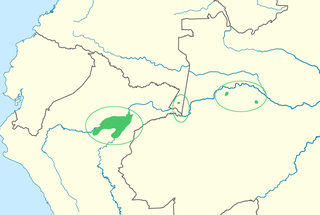
Summary
Cocama (Kokáma) is a language spoken by thousands of people in western South America. It is spoken along the banks of the Northeastern lower Ucayali, lower Marañón, and Huallaga rivers and in neighboring areas of Brazil and an isolated area in Colombia. There are three dialects. The robust dialect is known as Cocama, Kokama, Kukama-Kukamiria, Ucayali, Xibitaoan, Huallaga, Pampadeque, and Pandequebo. By 1999, Cocamilla (Kokamíya) was moribund, being only spoken by people over 40.
| Cocama | |
|---|---|
| Kokáma | |
| Native to | Perú, Brazil, Colombia, Venezuela |
| Ethnicity | 16,000 Cambeba et al. (2007),[1] Kokama |
Native speakers | 250 in Peru (2007)[1] few in other countries |
Tupian
| |
| Language codes | |
| ISO 639-3 | cod |
| Glottolog | coca1259 |
| ELP | Cocama-Cocamilla |
 | |
Out of a projected ethnic population of 15,000, the majority of Cocama speakers, 2,000, live in Perú. Remaining speakers live in Amazonas state in Brazil, where 50 out of 411 ethnic Chayahuitas speak it and it is known as Kokama or Kokamilla. Most speakers are trilingual and can also speak Portuguese and Spanish. Very few are monolingual. There are 20 ethnic groups in Colombia's Lower Putumayo area with an unknown number of Cocama-Cocamilla speakers. Most expected speakers would also be trilingual, but the language may be extinct in the region.
Cocama speakers have a 3% literacy rate, compared with 50% for Spanish. Grammar rules have been developed and the language is written using the Latin script. Parts of the Bible have been translated into the language.
Cocama is closely related to Omagua, a nearly extinct language spoken in Peru and Brazil.
Phonology edit
Consonants edit
| Labial | Alveolar | Palatal | Velar | |
|---|---|---|---|---|
| Plosive | p | t | k | |
| Fricative | x | |||
| Affricate | t͡s | t͡ʃ | ||
| Nasal | m | n | ||
| Tap/Flap | ɾ | |||
| Semivowel | w | j |
Plosive sounds may also be realized as voiced.[3]
Vowels edit
| Front | Central | Back | |
|---|---|---|---|
| Close | i | ɨ | u |
| Mid | e | ||
| Open | a |
Phonetic realisations edit
| Phoneme | Allophones |
|---|---|
| /p/ | [p], [b] |
| /t/ | [t], [d] |
| /k/ | [k], [ɡ], [kʰ] |
| /ts/ | [ts], [s], [tʃ] |
| /tʃ/ | [tʃ], [ʃ] |
| /n/ | [n], [ɲ], [ŋ] |
| /ɾ/ | [ɾ], [l] |
| /w/ | [w], [β] |
| /j/ | [j], [z] |
| /i/ | [i], [ɪ], [e] |
| /e/ | [e], [ə], [ɪ] |
| /ɨ/ | [ɨ], [ɪ] |
| /u/ | [u], [ʊ], [o] |
Revitalization efforts edit
In 2013, residents of Nauta, Loreto Province, Peru created a children's rap video in the Kukama-Kukamiria dialect, in collaboration with Radio Ucamara. The local radio station has been involved in efforts to preserve the language for "a few years," and "started managing a school called Ikuar, with the goal of teaching the language through songs and traditional story telling."[4]
References edit
Notes edit
- ^ a b Cocama at Ethnologue (18th ed., 2015) (subscription required)
- ^ Cabral (2012) argues that Kokama/Omagua is a mixed language, and so not directly classifiable, though most of its basic vocabulary is Tupi–Guarani.
- ^ Vallejos Yopán (2010)
- ^ Ortiz, Diego M. (2013-08-09). "Children's rap video gives new life to Peruvian indigenous language". Latina Lista. Retrieved 2013-08-20.
Sources edit
- Vallejos Yopán, Rosa (2010). A grammar of Kokama-Kokamilla (PhD thesis). University of Oregon. hdl:1794/11051.
Further reading edit
- Michael, Lev (2014). "On the Pre-Columbian origin of Proto-Omagua-Kokama" (PDF). Journal of Language Contact. 7 (2): 309–344. doi:10.1163/19552629-00702004.
- Vallejos Yopán, Rosa (2009). "The Focus Function(s) of =pura in Kokama‐Kokamilla Discourse". International Journal of American Linguistics. 75 (3): 399–432. doi:10.1086/605418..
- Vallejos Yopán, Rosa (2014). "Reference Constraints and Information Structure Management in Kokama Purpose Clauses: A Typological Novelty?". International Journal of American Linguistics. 80 (1): 39–67. doi:10.1086/674160..
- Vallejos, Rosa. A grammar of Kukama-Kukamiria. Leiden, The Netherlands: Brill, 08 Apr. 2016. ISBN 978-90-04-31452-8. doi: https://doi.org/10.1163/9789004314528
External links edit
- "Language: Cocama-Cocamilla". Summer Institute of Linguistics Peru: Investigating the Languages and Cultures of Peru. 2009. Retrieved 2013-08-20.[permanent dead link]
- "Cocama". World Atlas of Language Structures Online. Retrieved 2013-08-20.
- OLAC resources in and about the Cocama-Cocamilla language
- OLAC resources in and about the Omagua language
- ELAR archive of The Kukama-Kukamiria Documentation Project


